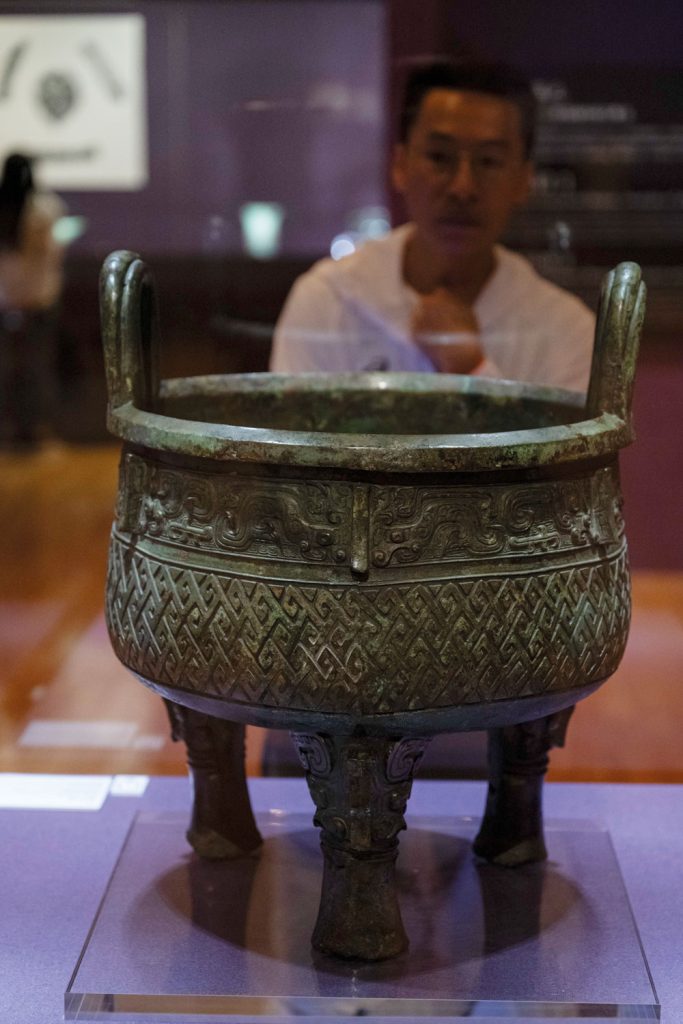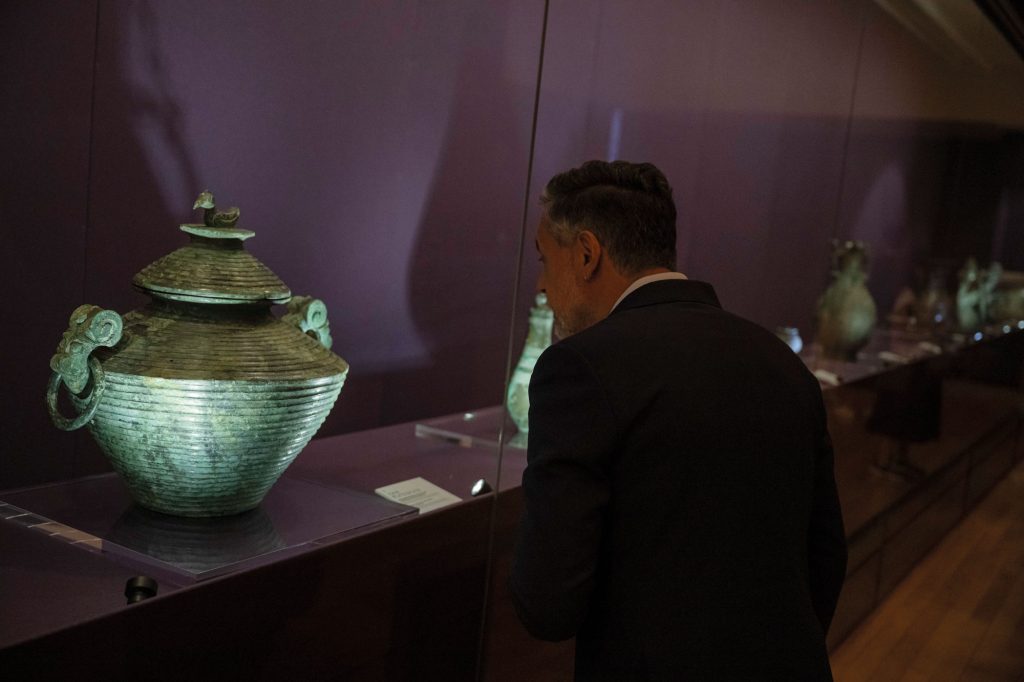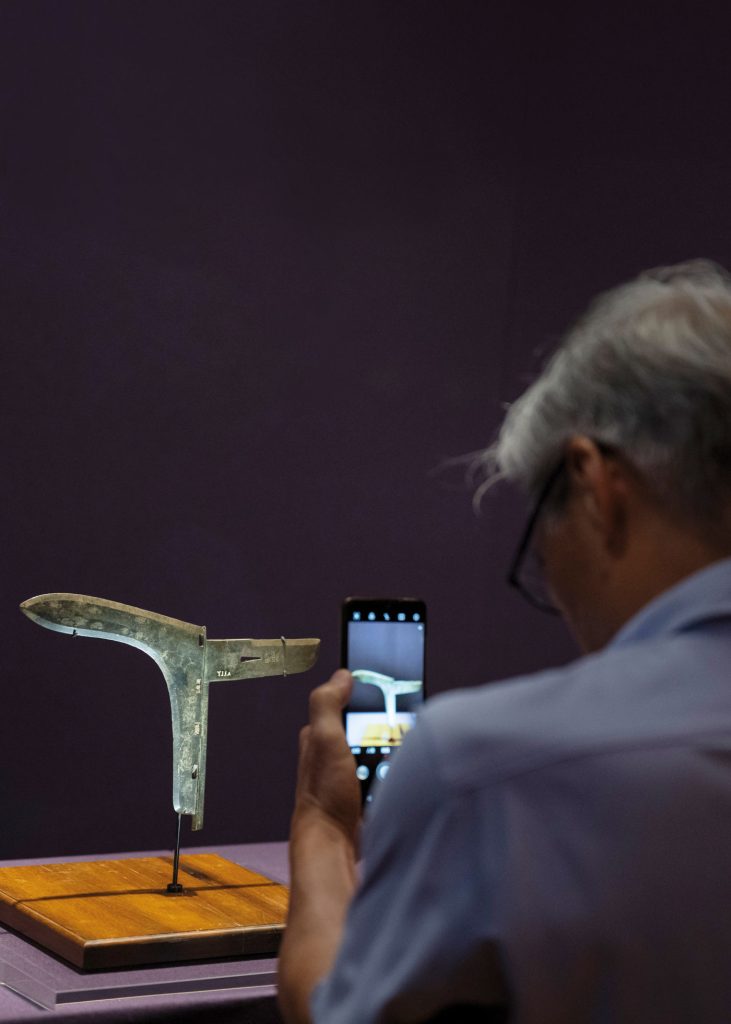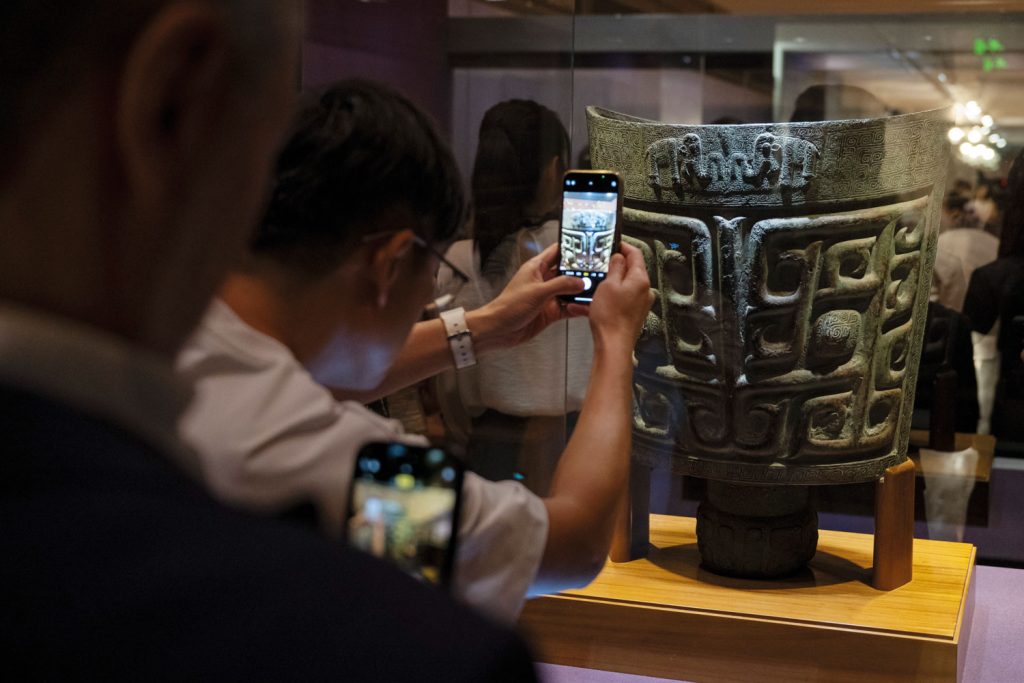Step into “The Splendour of Chinese Bronzes” exhibition at the Macao Museum of Art (known by its Portuguese initials, MAM), and find yourself transported thousands of years into the past. The time-worn sheen of ancient metalwork draws you closer, and some pieces – like a mysterious mask from the Sanxingdui archaeological site – may even appear to stare back. This particular mask, a relic dating back to the late Shang dynasty (c. 1250–1046 BCE), still baffles archaeologists today. With its protruding ears and insect-like eyes, who (or what) could it be?
While precise answers remain elusive, archaeologists believe these types of masks were probably positioned atop poles during religious ceremonies, representing ancestors. Today, they serve as a silent reminder of an early Chinese society’s depth and complexity. Sanxingdui, in Sichuan Province, has offered up a wealth of treasures from the realm of ancient Chinese metallurgy – many of them hailing from the Shu kingdom, a civilisation that existed more than 3,000 years ago. The site was first discovered in the 1920s, though excavations only got underway in the 1980s.
MAM’s exhibition, which runs until 10 November, contains bronzes from civilisations across China. The more than 150 artefacts on loan from the National Museum of China hail from the Xia (c. 2070–1600 BCE) to the Western Han (c. 202 BCE–8 CE) dynasties. And they aren’t just feasts for the eyes; these bronzes convey history. While they are all examples of funerary goods, meaning they were specifically made to be buried in tombs, their forms represent a myriad of purposes, from ancestor worship to military communications. Each artefact tells its own story, but together they weave a larger narrative of insights into the lives, beliefs and systems that shaped ancient China.
A glimpse into the past

One of the exhibition’s most captivating sets of objects comprises a three-legged bronze cauldron, or ding, and two-handled containers known as gui. These date back to the middle Western Zhou dynasty (c. 1046–771 BCE) and their inscription reveals they were cast by a man named Si to honour his father. It recorded Si’s hopes for his descendants (he wished them lives filled with prosperity) and that he had received praise and rewards from the king.
Ding and gui are ceremonial vessels that, while no longer used in everyday life, have a special linguistic legacy in China. The word ‘ding’ is associated with strength and the phrase “inquiring of the ding” suggests a quest for power. The word ‘gui’ appears in the Cantonese term “nine large gui”, referring to a grand feast. Examples like these show the threads still connecting ancient China to the present day.
Inscriptions are common on bronzeware; they often detail personal achievements or political events. Duke Huan of Tian Qi (c. 400–357 BCE), an important leader in present-day Shandong Province during the Warring States period (c. 481–221 BCE), had a bronze dui cast in the 14th year of his reign that included an inscribed record of tributes he’d received from other leaders. That dui – a spherical food container fashioned from two semi-sphere bowls, sporting a number of loop handles – is also on display in MAM’s exhibition.
Some of the inscriptions are people’s names, executed in beautiful calligraphy. A ge (dagger-axe) from the Warring States period, is inscribed with the name of the highly successful statesman Lü Buwei, who died in 235 BCE, in today’s Sichuan Province. Lü Buwei administered the state of Qin, a feudal kingdom, which introduced strict rules around weapon-making: each item was required to bear the names of its bladesmith and the state’s current leadership.
Bronze casting, the craft

China’s Bronze Age began around 2000 BCE and lasted about 13 centuries. Early bronzes were cast in a single take – a process requiring immense precision. Later artisans developed the piece-mould casting technique, allowing for more intricate designs and larger vessels.
The first step in piece-mould casting involved fashioning a model of the desired object from clay. That solid core was then covered with another layer of clay, which – when dry – would be cut away in sections (the ‘pieces’ the technique derives its name from). The original model would be shaved down to a smaller version, and the layer of pieces reassembled around it to make the outer walls of a mould. Molten bronze would be poured in, solidifying in the cavity complete with any incised decorations. After the bronze cooled, the mould was broken away to reveal the finished object.
MAM’s exhibition contrasts two jia (ritual wine vessels) cast using each method, their differences illustrating the evolution in casting techniques.
Bronze is an alloy of copper, tin and lead. It oxidises over time, developing a distinctive greenish hue. This effect is very apparent in a bronze yue (battle axe) adorned with an openwork human face, from the late Shang dynasty, that’s included in the exhibition. ‘Openwork’ is the term for designs that appear lace-like, where parts of the metal are cut away to create open spaces.
However, a few pieces in the exhibition have managed to retain their original dark golden colour, even after thousands of years. The ‘Qin Gong’ bronze hu (another style of ritual vessel) from the early Spring and Autumn period (c. 770–476 BCE) is one such example, its surface remarkably well preserved due to the environment in which it was buried.
An aesthetic evolution

“The Splendour of Chinese Bronzes” offers visitors the chance to see how bronze craftsmanship evolved over centuries – beyond the style of casting. Early Shang dynasty ritual wine vessels, such as the jue and gu, are characterised by simplicity. They were often found in tombs: the more a burial site included, the higher the status of the tomb’s occupant.
Over time, with the evolution of casting methods, decorations also became more elaborate. The exhibition features sophisticated wine vessels bedecked with lotus-shaped crowns, or with realistic bird motifs on their lids. As different cultures interacted more, as the northern nomads did with people living on the Central Plains, their designs merged and morphed – reflecting increasing integration within China.
Later bronzes, such as a pair of kneeling figures from the Western Han dynasty, show an extraordinary attention to detail. These figures – one male, one female – once held umbrellas (the canopies are now lost). Their exquisitely cast facial features and costumes reflect regional characteristics. Archaeologists think the couple originally belonged on top of a bronze drum, indicating the person they were buried with had very high social status.
Fantastical beasts

The intricate imagery adorning later bronzes is particularly intriguing: depictions of mythical two-bodied creatures are not unknown. The faces of these beasts are typically highly stylised and symmetrical, with distinct nasal bridges between the eyes and snout. In the exhibition, an ancient chariot’s axle cap from the early Spring and Autumn period displays a mysterious combination of creatures that archaeologists still haven’t figured out the meaning of. There’s a tiger devouring a person’s head, along with two snakes and two additional human heads.
Phoenixes, turtles, fish and dragons are more common motifs on Chinese bronzes, along with abstract patterns representing clouds and thunder. These forms of imagery reflect an ancient Chinese belief in the interconnectedness of the natural and supernatural worlds.
The exhibition also features a bronze nao, a percussion instrument from the late Shang dynasty, decorated with elephants. Nao were used in military contexts, and according to the ancient text The Rites of Zhou, their sound was a signal that troops should retreat. In this piece, the elephants face each other head-to-head – a motif that was popular from the Shang to early Zhou periods.
Exploring the exhibition, taking in the explanations that accompany each exhibit, it becomes clear “The Splendour of Chinese Bronzes” offers up far more than physical relics. It provides visitors with a tangible connection to the people who were buried with these objects, and to those who remained above ground.
These precious bronzes, crafted to be symbols of power and means of connecting with the divine, serve as a testament to the ingenuity and artistry of ancient China. Through them, we can glimpse a world that, while distant in time, still resonates today.



